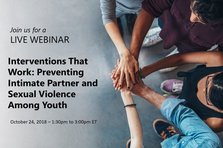|
The HHS Office on Women’s Health (OWH) knows how important it is for you to have the latest information on prevention and treatment to help you best serve your patients. Each month, we will share a curated list of tools and resources that you can immediately put into practice.
Intimate partner violence (IPV) is a serious, preventable public health problem that affects millions of Americans, including youth. Research suggests that unhealthy, abusive, or violent relationships can have short- and long-term negative effects on developing teens, and teens who experience dating violence are at increased risk for violent relationships as adults. Health professionals play a critical role in helping teens have healthy relationships. This Domestic Violence Awareness Month, review the following tools and resources to learn how you can identify risk factors and support efforts to prevent dating violence.
 Interventions That Work: Preventing Intimate Partner Violence and Sexual Violence Among Youth
The Community Preventive Services Task Force (CPSTF) recently released a recommendation for interventions that aim to prevent or reduce IPV (dating violence) and sexual violence among youth. This recommendation is based on a systematic review of 28 studies. The findings showed interventions reduced intimate partner and sexual violence among youth. Results also showed an increase in bystander action within the first six months of completing the intervention, meaning bystanders intervened when they noticed a risky situation or challenged aggressive attitudes toward women, such as offensive jokes or objectifying language. You can learn more about the CPSTF’s recommendation and strategies designed to prevent violence among youth by attending the free Interventions That Work webinar from 1:30 to 3 p.m. ET on October 24, 2018. Register now!
|
 Preventing Intimate Partner Violence Across the Lifespan
Use these technical packages from the Centers for Disease Control and Prevention (CDC) to implement strategies and approaches to reduce violence among teens in your community. They are aligned with the CPSTF recommendation and are based on the best available evidence to help communities and states sharpen their focus on prevention activities with the greatest potential to prevent IPV and its consequences across the life course.
|
 Hanging Out or Hooking Up: Clinical Guidelines on Responding to Adolescent Relationship Abuse
Health professionals are uniquely positioned to identify dating violence among young people. This guide from Futures Without Violence focuses on the transformative role health professionals who treat adolescents can play in preventing, identifying, and addressing teen dating violence. You can use these guidelines in a range of settings serving adolescents, including adolescent health programs, pediatric settings, family planning clinics, and school-based health centers.
|
Share With Your Patients
Encourage your teen patients and their parents to review these resources and materials on teen dating violence:
For teens:
For parents:
For more updates on women’s health, follow OWH on Twitter.
|